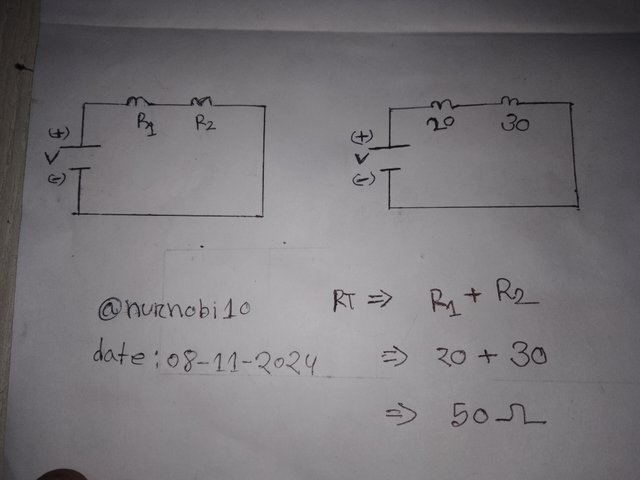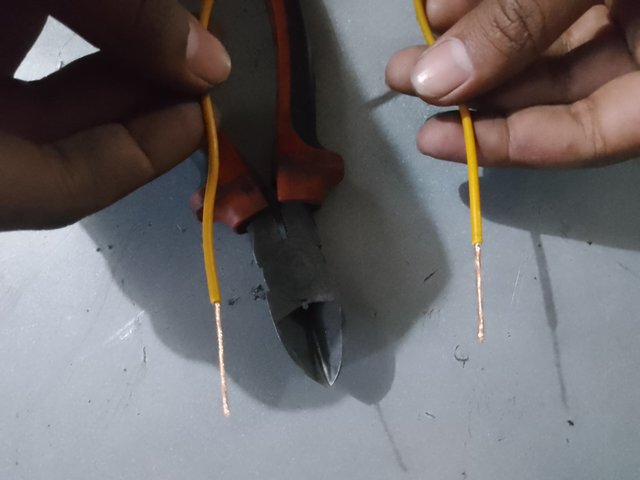How is everyone, hope everyone is well and healthy. Between us Mr. @solaymann sir and Mr. @mahadisalim sir SLC21/WK2: Introduction to Basic Electrical Circuits & Cable Joint. I feel happy to participate in this competition organizing an Announcement because it will be a medium to express our competence and to acquire skills in electrical subjects. I thank you sir @solaymann sir @mahadisalim sir for organizing this competition. I am very happy to participate in this competition as it is very interesting and educational.

Design by canva
We know that a circuit through which current flows is called an electrical circuit. And the electric circuit is a circuit breaker, and the most necessary for the current flow is that we can't supply current through the battery light motor connection wire. doesn't happen And no fear of fire connection.
Regulation of current flow: A circuit provides a controlled path for current flow like its pea battery capacitor ensures that it supplies us with current.
Advanced technology and electronics devices: These circuit devices play a very important role in the design of electronic devices such as computers and mobiles.
Functionality and safety of circuit devices: Properly designing a circuit and making it efficient and safe to use electricity in the circuit helps prevent overheating or short circuits.
And the importance of the circuit in electrical engineering is infinite because this current acts as the basis of every electrical system and provides maximum power with proper use of current.
1) Flow of current: In series circuit I know one is connected to another and current flows through one path. As a result the same current flows throughout the circuit.
And parallel circuits are connected separately and although different currents flow in each branch, the total current is the sum of the currents in the different branches.
2) Voltage distribution:In a series circuit, the voltages in each circuit component are divided but the sum of the voltages is equal.
And in parallel circuit each branch has equal voltage and same voltage is applied to all branches.

It is a series circuit. There are two resistors, -R1 and R2 respectively.
Here the value of R1 is 20 Ohms and the value of R2 is 30 Ohms respectively. Here the resistors R1 and R2 are connected in series line respectively. We know that to find out the series resistance of series line we have to add each time. So here the sum of R1 and R2 is The value will be the total resistance. That is, the sum of the two resistances is -R1+R2=20+30=50 ohms. That is, this Total resistance in the circuit = 50 ohms respectively.

Now we will discuss another circuit. This is a parallel circuit. There are two resistors which are =R1 and R2 respectively. Here resistors R1 and R2 are connected in parallel line. From this circuit we understand that when a unidirectional current spreads in two or more lines it is called parallel line. The rule to find total resistance of parallel line is different from series line. Here value of R1=200 Value of Ohms and R2 = 300 Ohms. Now to find the total resistance I have to multiply the values of R1 and R2 once here. Then the product of R1 and R2 is = 60,000 ohms respectively. Again the values of R1 and R2 need to be added. The sum of R1 and R2 respectively = 500 ohms. Now to find the total resistance the product of R1 and R2 = 60000 ohms plus the sum of R1 and R2 Divide the value = 500 ohms. That is 60,000 ÷ 500 = 120 ohms. This is 120 Ohms is total resistance.

★Firstly this cable joint requires a half meter of flexible cable, a cutting pliers and a combination pliers.

★The first step of this task I have to cut the rubber part of the cable about an inch from the cable head and expose the copper installation.

★ In this way copper insulation should be removed by one inch of two cables.

★Then connect the two parts of the two cables tightly together.

★ Must be careful in pairing so that the pairing is tight and the pairing should not come apart later.
Series Circuit: What I learned about series circuit and parallel circuit and cable joining are:
Series Circuit: We have learned through series circuit that current flows from one side and output from the other side to reduce current flow.
Parallel circuit: Through parallel circuit, current can be inputted from one direction and output output is different or more than one input can be done as follows.
Cable Join: We have demonstrated proper joining by cutting this cable and it will be useful for us in future.
And I extend my best wishes and congratulations to you on this exciting event

@tipu curate
Downvoting a post can decrease pending rewards and make it less visible. Common reasons:
Submit
Upvoted 👌 (Mana: 3/8) Get profit votes with @tipU :)
Downvoting a post can decrease pending rewards and make it less visible. Common reasons:
Submit
This is my Twitter share link : https://x.com/NurNobi68258/status/1855199525113340319?t=R-NgoU5hh1ezyPoqC8rT3Q&s=19
Downvoting a post can decrease pending rewards and make it less visible. Common reasons:
Submit
At point A you defined the circuit very simply. You can define the circuit more clearly. A circuit is a closed path through which one or more currents flow. Series circuit has one current path and parallel circuit has multiple current paths. (1.2)
You have not made the difference between series and parallel circuits very clear. You may note that in a series circuit, current flows in the same path back to the source, and in a parallel circuit, current flows in multiple paths back to the source. Another is that in series circuit the equivalent resistances are added and in parallel circuit the equivalent resistances are added as inverse and the equivalent resistance is reduced.
The circuit solutions and details you mentioned were good. The sum of the equivalent resistances in the circuit and its demonstration is excellent. (3)
You have successfully completed the cable joint step at point c. A series of pictures and descriptions clarify the steps of your cable joint. You were very careful about the cable joint. (3)
In the last point you mentioned your teaching points. It was really nice that you mentioned the things you learned from the lesson in point form. Thanks for sharing your learning experience. (1.4)
Comment/Recommendation
**Scores| 8.6/10
Downvoting a post can decrease pending rewards and make it less visible. Common reasons:
Submit